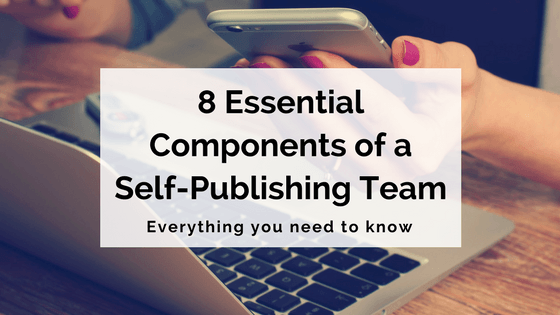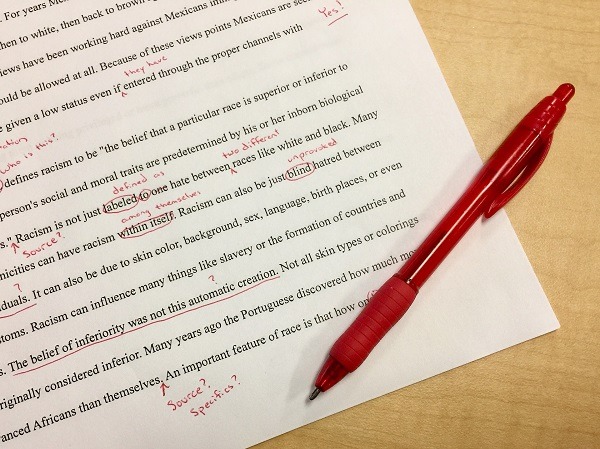So you’ve decided to self-publish your book. Congratulations! Indie publishing is constantly growing and evolving, and indie authors now have a better-than-ever chance at pursuing a successful writing career.
But if we’ve learned one thing when it comes to self-publishing, it’s this: you can’t do it alone.
The word ‘independent’ in ‘independent author’ does not mean ‘solitary’. In fact, to publish your own book with any chance of success, you’ll need a small team to help you along the way.
Let’s talk about the eight essential components of a self-publishing team: who they are, what they involve, and why you need them.

Table Of Contents
Editorial team
The first team members you’ll need to assemble will work on the editorial aspects of your book. Just like any traditionally published book, an indie novel needs extensive editorial work to ensure it’s the best possible quality before it’s published.
There are three main types of editorial team members for self-publishing: beta readers, editors and proofreaders.
1. Beta readers
We’ve talked previously about how to work with beta readers to improve your novel. We recommend the beta reader process to writers seeking traditional publication too, but for indie authors, it’s even more important.
For those unfamiliar with the term, a beta reader is someone you engage to read and provide feedback on your unpublished manuscript. They aren’t professional editors, and they usually read your novel for free (we recommend returning the favour, if possible).
So why exactly do you need beta readers on your self-publishing team?
First of all, they can provide much-needed perspective on your work. It can be hard to distance yourself from a novel you’ve spent countless hours immersed in, so it’s imperative to seek an objective outsider’s perspective when you’re finished your first draft.
Beta readers also give you the chance to see how readers might respond to your book. Before you seek professional editorial services (more on that below), it’s super helpful to get reader-centric feedback from beta readers. You should ideally choose beta readers who already read widely in your genre, as they’ll best represent your target audience.
Considering and incorporating beta reader feedback when revising your novel will help you get it in the best shape possible before it goes off to your editor.

2. Editor
Whether indie or traditional, an author’s best friend is their editor.
Every novel needs the attention of a professional editor before it’s published. Those seeking traditional publication will have an editor assigned to them by their publisher, but if you’re self-publishing, you’ll need to employ a freelance editor yourself.
You’ll work closely with your editor to develop and polish your manuscript until it’s entirely publication-ready. The editor’s role is an extremely important part of your book’s journey, so you want to be sure you choose the right person for the job.
Before you search for an editor, you need to decide what level of edit your manuscript needs.
If you’ve done your own extensive structural editing and are satisfied with the result, you may choose to hire an editor for copy edits only. However, you may choose to hire an editor for the ‘full package’ – a structural edit and a copy edit.
Now, we won’t lie: editorial services aren’t cheap (and nor should they be – beware the quality of ‘budget’ editors!). While it can be tough to absorb all the costs involved with self-publishing, this is one you cannot skimp on.
To be able to compete with traditionally published and fellow indie authors, your manuscript needs to be in the best shape it can possibly be – and for this, you need a great editor.
3. Proofreader
The final member of your editorial team should be a proofreader.
‘But my book’s already been edited,’ you might say. ‘Do I really need a separate proofreader as well?’
In our opinion, the answer is absolutely yes.
Hiring a separate proofreader gives you the best possible chance to catch and correct any remaining errors before publication. Typos; formatting issues (more on this below); last-minute spelling, punctuation and grammar mistakes – all these will be the sole focus of your proofreader.
In today’s saturated indie publishing market, it’s more important than ever to ensure your self-published book is the most polished product possible. Hiring a proofreader will help you achieve this.

Design team
You also need to put together a design team to complement your editorial team.
We can’t stress enough how important professional design elements are when you’re self-publishing. And we don’t just mean the cover; you’ll also need to consider the interior design of your book and seek out a typesetter and an ebook formatter.
4. Cover designer
We all know books shouldn’t be judged by their covers – but we also know that a lot of the time, they are.
A great cover is something that’s particularly important for indie authors. Along with the blurb, it’s the first thing potential readers will see, and it will play a big part in them deciding whether they’ll read your book or not.
For this reason, we don’t recommend trying to design your book cover yourself (unless you’re a professional designer as well as a writer). If you really want to ensure your book cover is a winner, you’ll need to bring in a cover designer.
Yes, hiring a cover designer is an expense – but it will be well worth it when you have a beautiful, professional cover to help you sell your book.
Your cover designer will design a front and back cover (complete with spine) for your book. If they know what they’re doing (and they should), the cover will appeal both digitally and in print, attracting readers and representing the genre, style and content of your book.
When it comes to choosing a cover designer, we can’t stress enough the importance of research. Most importantly, you need to look at each designer’s past work. Seeing book covers they’ve designed will give you an idea of whether they are a) a good quality designer, and b) right for your book.

5. Typesetter
As well as having a cover designed, the interior layout of your book will need to be arranged and typeset by a professional.
Interior design elements such as title pages, chapter headers and the appearance of the text itself are just as important as a book’s cover. If a book is unprofessionally formatted, readers aren’t likely to think highly of it. You want the inside to look as beautiful as the outside!
Many design roles in publishing have merged and changed in recent years, so your cover designer may in fact be able to typeset your book as well. If not, you’ll need to seek out a separate typesetter.
If your cover designer does offer typesetting, make sure they have the experience required to do the job. Just as you did with their previous covers, ask to see samples of books they’ve typeset so you can confirm they know what they’re doing with the interior as well as the exterior of your book.
6. Ebook formatter
If you’re wondering whether you need to release your book in print and ebook format, in our opinion, the answer is definitely yes.
Publishing your book in both formats is pretty much an essential these days, especially if you’re an indie author. First and foremost, it allows you to reach a wider audience, but it also carries a range of extra benefits.
Perhaps the most appealing of these is the cost factor. Unlike a print book, which incurs printing and distribution costs that fall back on you as an indie author, an ebook only involves the one-time production cost incurred at the formatting stage – meaning you get to keep a much higher percentage of the price readers are paying for your ebook.
So! Now you know how important it is to publish your book in a digital format, it’s time to find yourself a professional ebook formatter.
Converting a manuscript file to a proper ebook format isn’t as easy as it may sound. Ebooks must be formatted to a set of guidelines set out by your chosen ebook distributor (more on distribution below).
You can complete this stage yourself if you really want to, but we do recommend hiring a professional formatter to make sure your manuscript is converted perfectly into an ebook.
Your typesetter may have experience in ebook formatting as well; if this is the case, again, we recommend checking out a few samples of their previous ebook work just to be on the safe side.
If your typesetter doesn’t offer ebook formatting as well, you’ll find plenty of other professionals who do.

Production/Distribution
So your book’s been beta-read, edited, proofread, typeset and digitally formatted, and a killer cover has been designed. You’re almost there! Now it’s time to consider production (i.e. print copies) and distribution, both online and in bricks-and-mortar bookstores.
7. Printer
For physical copies of your books, you’ll need to engage the services of a printer.
You can choose between two options here:
- Print-on-demand – where you order copies to be printed only when people want them.
- Print run – where you order a certain number of copies to keep on hand and distribute as needed.
There are advantages and disadvantages to both options. Print-on-demand saves you outlaying larger payments for bulk stock, and ensures you’ll never be stuck with more copies than you need. However, ordering a print run might be more cost-effective in the long run, as the unit cost is usually lower than print-on-demand.
As always, be sure to do your research when it comes to selecting a print service. Request samples so you can analyse things like paper stock, binding and overall print quality.

8. Online/physical distributors
Perhaps the most exciting step in your self-publishing journey is distribution. That’s right – it’s finally time to let people get their hands on your book!
While you can sell your books through your own website, you’ll also need to choose distributors for both the print and digital versions of your book. Major retailers like Amazon will do both, whereas others such as Kobo focus solely on ebooks.
You can distribute your ebook yourself by individually uploading your book to each online platform, or you can entrust it to an ebook distribution service such as BookBaby or Vearsa.
Physical distribution can also be arranged for you through a service such as IngramSpark, which has an established network of global print distribution partners. However, there are obviously costs involved in distribution services for both ebooks and print.
You may also be wondering whether you should you approach local bricks-and-mortar bookstores about stocking physical copies of your book. However, this can be a costly option for indie authors for a number of reasons:
- It involves ordering a print run.
- Bookstores will need to purchase your books at a much lower cost so they can make a profit to cover their own overheads.
- Bookstores have a ‘sale or return’ policy – meaning if your books don’t sell, they’ll be returned to you (at your cost).
For these reasons, first-time self-publishing authors might prefer to initially stick with online distributors to save yourself some money, time and hassle. Besides, it’s worth keeping in mind that the majority of book sales these days happen online rather than in physical bookstores anyway.

***
So there you have it – the eight components of your very own self-publishing team. Once you’ve enlisted all the services we’ve talked about here, you’ll be well on your way to creating a high-quality self-published book and embarking on a successful career as an indie author.